Zagreb Pride Reports Homophobic Incidents on Korčula Island
ZAGREB, 13 Aug 2021 - A group of queer friends from several countries were thrown out of the Lost in the Renaissance festival on the southern Adriatic island of Korčula last weekend in an incident motivated by homophobia, Zagreb Pride reported on Friday.
According to Zageb Pride, at the end of the first day of the festival, held in The Jungle Club, outside Korčula town, one of the bouncers separated by force two young men who were dancing holding each other. The bouncer ordered: "No kissing, just dancing!"
Shortly after that, another bouncer poured a bottle of water onto another two young men who were napping on a bench in each other's arms. In the end, the bouncers kicked the young men out, Zagreb Pride said.
The homophobic incidents were reported to Zagreb Pride, the organisers of the Lost in the Renaissance festival, the Aminess Hotel management and the Korčula town authorities.
Zagreb Pride said nobody reacted to the reported incidents.
Zagreb Pride also recalled another incident that took place in June in Zagreb where two Spanish women, during their business stay in Croatia's capital, suffered lesbophobic insults from Zagreb residents.
For more news, CLICK HERE.
3 Years: Oliver Dragojević Anniversary to be Marked in Vela Luka
July 20, 2021 - The Oliver Dragojević anniversary will be marked in Vela Luka on Korčula, where concert evenings will be held to remember the Croatian singer 3 years after his death.
When he closed his eyes forever on July 29, 2018, everyone shed a tear for the singer whose songs have marked and will mark the generations to come. Oliver Dragojević gave the region unforgettable hits, many of which will be sung again this year to mark the third anniversary of his death, reports Slobodna Dalmacija.
Vela Luka, where Oliver spent the most beautiful days of his childhood and where he now rests, is preparing two musical evenings in honor of the Croatian musician.
HRT will broadcast live from Korčula next Thursday, July 29, starting at 10 pm, as a concert will be held on the Second Program. The host of the event is Duško Ćurlić. The audience in Vela Luka, as well as the spectators in front of their screens, will have the opportunity to hear Oliver's most beautiful songs such as the inevitable "Cesarica," "Galeb," "Traga u beskraju", "Kad mi dodeš ti", and many others.
The songs will be performed by Gibonni, Tedi Spalato, Antonio Serrano, Marko Tolja, klapa Ošjak, and Dupini. Ante Gelo will take care of the great musical accompaniment with an orchestra conducted by Alan Bjelinski.
The second evening is reserved for young stars from the Croatian stage that we've met in various HRT shows such as "A strane" and "The Voice." This year's Croatian representative at the Eurovision Song Contest, the young Albina Grčić from Split, will sing in Oliver's honor.
Two days before the first concert, the exhibition "Oliver through the lens of Livio Andrijić," the head of the photo agency Cropix, will be officially opened. It contains 35 photos of the singer and can already be seen at the Vela Luka Cultural Center.
"When you're friends with someone, you don't think you should take a picture with them. If you happen to remember that, then you think: There is time, we will meet and take photos. And then it turns out that there was not enough time, that many of your moments together were not recorded in photos, but that is why they live forever in their hearts," Livio Andrijić said recently for Jutarnji list.
For more, follow our dedicated lifestyle section.
Injured Turtle in Korčula Bay: Rescued, Treated, Ready For New Life
July 17, 2021 - An injured turtle in Korčula Bay sparked immediate action by locals and vets, seeing the turtle being saved and getting a second chance.
Like many other places, towns, locations, and neighborhoods, Korčula also has groups on social media to ease communication among users who share the same place of daily life. Friday afternoon saw residents of Korčula have a big heart, and despite might being stereotypically perceived as laid back, chilled chaps (as for every Mediterranian-culture impacted people), they were quick to act when needed.
A user under the name Antoni Ja, one of the members of the FB group Oglasnik otoka Korčule (Korčula Island Message Board), reported on a 20 kilo turtle floating in the sea in Žrnovska Banja. Floating, the keyword.
„Please do something, so it doesn't get hit by a speedboat or some maniac“, said Antoni Ja.
Other users immediately started to worry if the turtle was injured, and the name of a local vet Vilović was suggested as an address to report the issue.
Sure enough, Vilović examined the turtle, and the 20-kilo turtle turned out to be over 50 kilos. Not quite often seen in shallow waters, but nevertheless a normal turtle size in the Adriatic sea.
„It had a head wound, most likely from the propeller. It is on its way to the Specialist in Split by catamaran“, briefly commented Vilović.
Indeed, as the photo on the FB group published by Ana Jurić shows, the turtle was on its way to Split.
„Kudos to the vet and the guys that organized all this, and the turtle is huge!“ wrote Jurić.
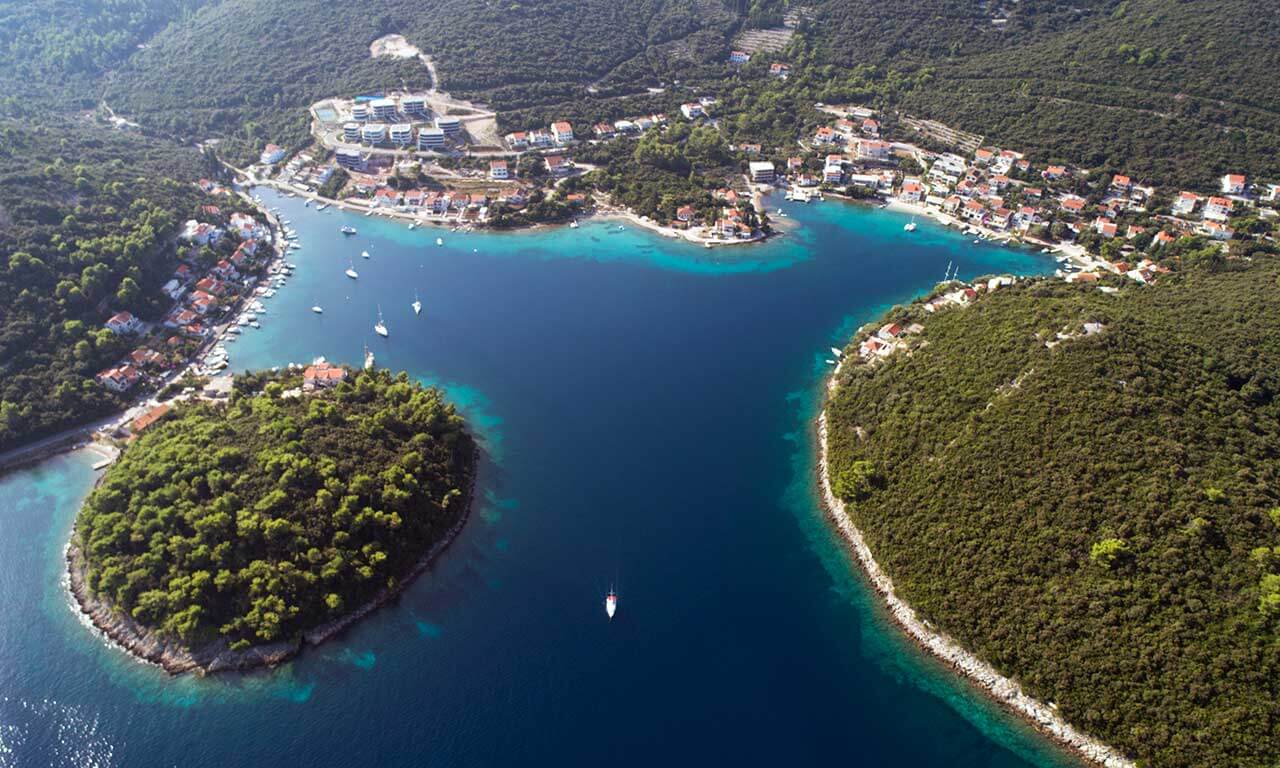
Zrnovska Banja where the turtle was spotted floating © Visit Korcula
Dr. Mario Gavranović, head of the VET VISION clinic in Split, confirmed that the turtle arrived on Friday night. „It should arrive in an hour or two. The propeller injury is an old wound and I will first have to examine it to see what is the proper way of treatment“, said Dr. Gavranović.
When contacted on Saturday morning to provide more information on what happened to the turtle, dr. Gavranović wasn't in his office. As confirmed by Aquarium Pula, the reason was Gavranović took the turtle to the aquarium which also has a Marine turtles rescue centre.
"The turtle is alright, on its way and should be in the Centre around midday", briefly confirmed Aquairum Pula.
Pula's rescue centre has been active for around 17 years (with turtles being strictly protected in Croatia since 1995 as one of the most endangered animal species), and Morski.hr wrote in 2019 how the centre cured over 100 turtles.
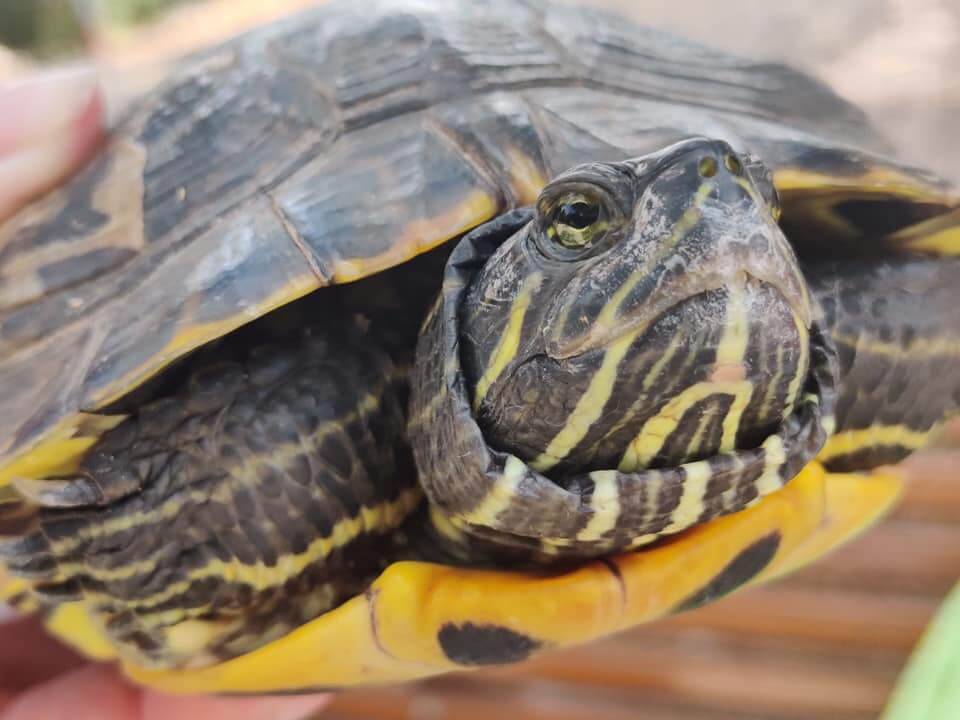
One of the many rescued turtles by Marine turtles rescue centre © Aquarium Pula
Croatia loves its animals
With vets displaying their expertise, locals on Korčula once again demonstrated their compassion and big heart when it comes to animals. And that compassion is not different from the general mood in Croatia.
With the nourishing of the recently deceased stork Malena being the most famous story of love between Croatians and animals, there were plenty of other examples too. From rejoicing every time whales or dolphins are spotted, when sheep visited the Zadar mall or when a Croatian reality TV star Jasmin Kunišinac raised a fox.
Unfortunately, Croatia also records cases of animal cruelty, such as the poisoning of cats and dogs, and each time Croatian public met it with a fierce backlash and anger for such acts.
Despite quite often arguing about everything imaginable and unimaginable, Croatians also express solidarity with each other when things get tough. For instance, many cities canceled their new year celebrations and relocated the money to Petrinja following its earthquake, as well as Croatian entrepreneurs too. But, many more instances of help were noted over the years.
Learn more about Korčula on our TC page.
For more about animals in Croatia, follow TCN's dedicated page.
Korčula Island Label Marks Quality Accommodation and Tourism Services
July 8, 2021 - The new Korčula Island label connects all forms of accommodation and special interest tourism providers with a quality label, all to strengthen the destination.
According to the Project Association of Local Tourist Boards from Korčula Island Agreement (Korčula Tourist Board and the Municipalities of Vela Luka, Blato, Smokvica, and Lumbarda), a Public Invitation was sent for inclusion in the project "Korčula Island," reports HRTurizam.
This is a quality labeling project called "Korčula Island." It is a group of standards and benchmarks that seek to create a new basis for connecting nostalgia of all forms of accommodation and providers of services in tourism of special interest with the quality label. It complements the existing categorization system to increase service quality and competitiveness.
The goals of the project are to increase the quality of the tourist offer of all forms of accommodation, strengthen the visibility of the segment and thus strengthen the destination brand, encourage specialization towards different target groups, diversify tourist products and open new markets, create significant strategic advantages and preconditions for extending the season and encourage establishing partnerships of all stakeholders involved in the process for better cooperation and joint promotion.
The quality label is awarded to stakeholders in tourism from the island of Korčula who have expressed interest in receiving this label for hotels, camps, private accommodation, and travel agencies. Also, sub-brands of this label will be created, such as quality labels for the following categories: “Hikers-friendly,” “Bike-friendly,” and “Eco-friendly.”
The completed application form, together with the documentation from the Public Invitation, must be submitted to the office of the local tourist board no later than August 6, 2021. Find out more about the application HERE.
For everything you need to know about Korčula Island, follow our dedicated Total Croatia page.
For more on travel in Croatia, follow TCN's dedicated page.
Once There Was a Peasant in the Town of Korcula
June 13, 2021 - Memories of Korčula, and Matko, for some the life and soul of the island - recovering from a severe stroke, with your help.
I’ve been coming to the most beautiful island in Croatia for 10 years now. Anniversaries are usually fun. Memorable. But so was my every stay on Korčula.
Korčula has given me so much.
Friendships beyond logic and measure. Memories that don’t fade with life’s problems. Moments that came closest to the capability of time travel. Tastes, smells and hums that make you mention the Lord's name in vain.
The realization that a concert doesn’t have to be planned, it can happen spontaneously on the street of this Bastion of Croatian-Mediterranean-Venetian history.
My first Michelin star experience involving cucumbers as a main dish on the first floor of Lesic Dimitri, which is surprising if you ever met me (I’m a big-bodied carnivore). Why would I even order that? Still recommended.
The first time I witnessed that a Turk doesn’t have to be the bad guy in European legends/cannon, as proclaimed and argued by the renowned Croatian political scientist dr. Dejan Jović. So illustriously presented in the historical storytelling extravaganza called Moreška.
Insights into the history visible on the wooden floor where the original James Bond used to spill his tea. In his own place. And yes, he actually owned a place in the old town. Not much has changed. The drops are still there. I was privileged.
If you read the editorial section of Total Croatia News you could have encountered some of these bits of stories.
Then again, as I was told and numerous times realized, the true value of a certain place, in the end, is inseparable from the quality and nature of its locals. The people.
Whether all-known merchants, judges, politicians, diplomats, architects or just regular Joes, Korčula has given Croatia, Europe and the World so much. It’s a place where you can meet individuals who are changing the view of Dalmatian coast (in a good way) or just expanding the boundaries of local cuisine. It’s one of the few places in Croatia where I have met more people that want to come live there than ones trying to escape. Unfortunately, so rare in this country. True fact, people who spent more then the summer or longer periods of time here have the urge to apply for Croatian citizenship. With a good record of becoming Croats. Basically, Korčula itself is its best demographic measure.
I would argue it is one of the few places where you can, without a worry, let your young ones do a tour with the town garbageman around the old city and the little ones would come back knowing the lyrics of a rock song from the 70 or 80s. I’ve seen it. It’s safe, heartwarming, beautiful, just different...
Almost everything that I have learned about Korčula was embodied in a man a certain British fellow traveler described as the peasant in the town of Korčula. The man goes by the name of Matko. If you are from there, you most likely know him. There is a good chance that if you spend some time there you met him or heard of him. As a lady named Sarah, from the city of London, who spends her long summers on Korčula, once said: the world is so small if you know Matko.
He was the middle man to many of my cherished friendships and the godfather to an abundance of my life changing ideas and incentives.
He was even around helping and consulting me in making the arrangements for my marriage proposal to my wife. The special event happened on the top of Marco Polo’s house, and everything was perfect. Even the sunset, although I don’t give him credit for that. I still had to carry the box with the ring in my underwear all the way from Prizba and ask her on our very own Slik Road personally, however that’s a story for another day.
Matko isn’t there these days.
Walking down the streets of Korčula I’m not hearing the sounds that used to fill me up with life in the most cliche way imaginable. Only in spending a few hours with him by his tavern he was able to draw a New Zealander to preform the traditional Haka battle dance, a duo of Scottish ladies, a capella singers, who performed their national folk songs that made you think you’re closer to Glasgow then to Split or Dubrovnik, groups of Nashvillians citing and preforming the eternal country ballads of Vince Gill and Chris Stapleton, Julliard alums virtuosing at will or just anybody willing to do their Oliver tribute...all in a matter of hours or a night or two. Matko was the classic people’s person, middle man and a Gladwellian connector. A not so little person who continually made a big difference for all who ran into him, making them see Korčula in a more complex but also pure sense, falling enamored with the island and the old town.
Korčula is still the most beautiful place on earth. I might be biased, however I’m not a local. I travel out of the first capital of Croatia all the way up in the north. There is still so much to see, to get to know and to feel in Korčula. I urge you to visit and experience it yourself. I’m not familiar with anyone with the storytelling abilities to paint you the picture as good as the original on sight.
It’s just... I feel a tad spoiled. It seems there is no music, there is no country, the joy is on hold, in the streets of Korčula at this moment. Maybe it’s just early summer. Perhaps the weather.
Hope the music comes back. Hope he returns.
On April 3rd, 2020, Matko suffered a severe stroke and after couple of days at the hospital was put into a medically induced coma which lasted 44 days. He suffered 3 lung infections, a bladder infection and sepsis. He also had a craniectomy, removing 1/3 of his skull to relieve pressure in his brain. During this time, the medical staff did not exercise him at all because they were basically waiting for him to die. This resulted in severe contractures of joints on the left side of his body plus the partial paralysis that the stroke caused. The restrictions for covid already started so the family could not visit him. After the hospital treatment Matko was taken to a rehab center. Again due to covid the center was understaffed and his was neglected and his recovery was slow, painful and unsuccessful. The family was then informed of a private polyclinic in Croatia that offers a robot neurorehabilitation that is extremely expensive. With help from a local charity organization Matko attended the clinic for six months and made progress. Unfortunately he still has a long difficult road in front of him having to relearn to walk and perform basic human functions again and the funds are running low. He is also scheduled for rhinoplasty surgery in the upcoming weeks to replace the missing part of his skull. He had recently opened a restaurant with a partner and could not be there to work leaving Sandra at home with two young children and no income. Now she cannot work as she takes care of him and their young children. They also have to rent a 2nd apartment near the rehab center just so he can attend the 6 hour therapy sessions. Please help this family survive another one to two years of medical bills, rent costs and basic life needs. If Matko cannot get the therapy he desperately needs he may permanently lose functionality of some extremities and brain functions among other things. His only goal is to get back on his feet so he can work and support his family. Anything you can spare is GREATLY appreciated.
Blue Shark in Korcula Waters Spotted and Photographed
June 11, 2021 - Despite not being a very frequent occurrence, sharks have several reasons for appearing just off Croatian shores. Contrary to what many may believe, there is no reason to fear the sighting of this two-metre blue shark in Korcula, nor is it a concern to see any others, according to marine biologists.
The people of Korcula were surprised to see a two-metre shark swimming off the shores of Kneze on Korcula. The viviparous animal was photographed and, despite belonging to a species popularly feared around the world, there is no reason to be scared, as marine biologists made sure to point out. It was a blue shark, and they very rarely attack humans, reported likemetkovic.hr.
It may be easier for people to deal with sharks if they know that the probability of being attacked by them is one in 11 million.
The blue shark in Korcula fidgeted and wagged his tail as it approached the shore. Despite this not being a frequent occurrence, blue sharks have reached the shores before and, unfortunately, many people still fear an attack or hostility from them.
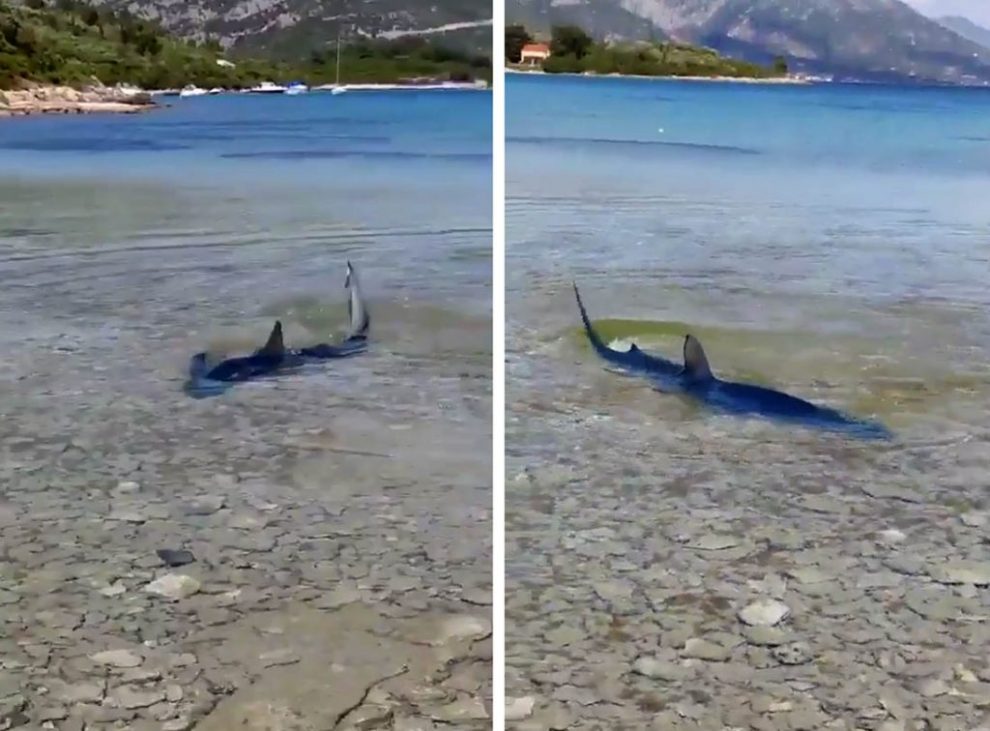
Photos: Franka Oreb (video screenshots from Twitter)
''They rarely come to the shoreline, but there are a few reasons for them to swim into the shallows. One is to feed, the other to get clean from parasites. Also, it should be borne in mind that this is the time when they reproduce and get closer to the coast,'' Petar Kruzic, a marine biologist, told RTL.
Shark fins were also seen circling around on Vis last April. And while a blue shark attracted by the blood of a fish can accidentally attack, it remains very unlikely.
Kruzic explained that the modrulj (blue shark in Croatia) belongs to the more dangerous species, and it very rarely attacks humans. They are dangerous when there are more of them, in a school of about five or six individuals.
"Like this, one or two of them will usually swim quickly from a human", he adds. So there is no reason to fear the blue shark in Korcula, or any other.
About 50 species of sharks are present in the Adriatic sea, and blue sharks usually feed on plankton, fish, seabirds, and crabs.For more, follow our lifestyle section.
Journalist Clickbait Victim: The Curious Case of Mystery Fish on Korčula
June 2, 2021 - When TC editor Iva Tatić caught the fish nobody could identify, TCN reporter Ivor Kruljac jumped to action in the hope he will find a marine life scoop. But after the dramatic realization that Atlantic lizardfish is nothing spectacular, he became a journalist clickbait victim. Meet the mystery fish on Korčula.
It was early evening between 7 pm-8 pm on the eastern Korčula coastline on May 28. After a long week of handling the Total Croatia site, TC editor Iva Tatić decided to chill and went fishing. Instead of managing the multilingual site that brings you the best tips on how to travel and enjoy Croatia, she must've been happy with the idea she can enjoy in Croatia herself, as she was preparing two hooks – one with a squid and the other with the piece of bread. Marine life must be very humble cause instead of a squid (absolutely delicious, either fried or grilled and stuffed with swiss chard), the bread was the taken bait for the careless fish soul underneath the Adriatic surface.
Iva took the opportunity and caught its prey, but pretty soon, happiness for the catch was additionally spiced with curiosity.
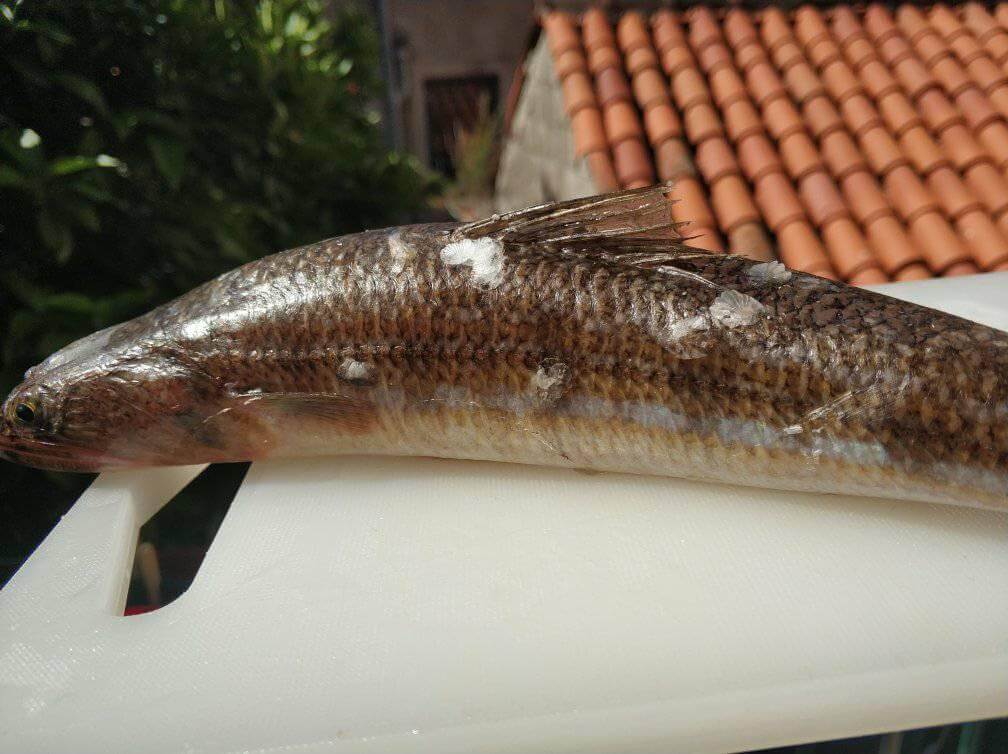
the source of curiosity and happiness © Iva Tatić
„What the hell is this?“ Iva asked the local Korčula fishermen showing them her catch.
And „no idea“ was the consensus by other marine life hunters.
„Locals call it the spider“, said a local fisherman known as Pero to Iva. „It looks like Spiderman“.
Iva didn't feel that Spiderman is an accurate comparison, and as no one really knew the answer, the whole thing went online.
After Iva shared the photos of its catch on Facebook, the online jury narrowed the mystery to two possible suspects: Saurida and Atlantic lizardfish.
Still being new and wanting to gain recognition in the newsroom, I took on myself to investigate what exactly is this Aquaman-Spiderman-love-child. Perhaps it's something invasive, a threat to the lovely Adriatic, and a fantastic journalist story.
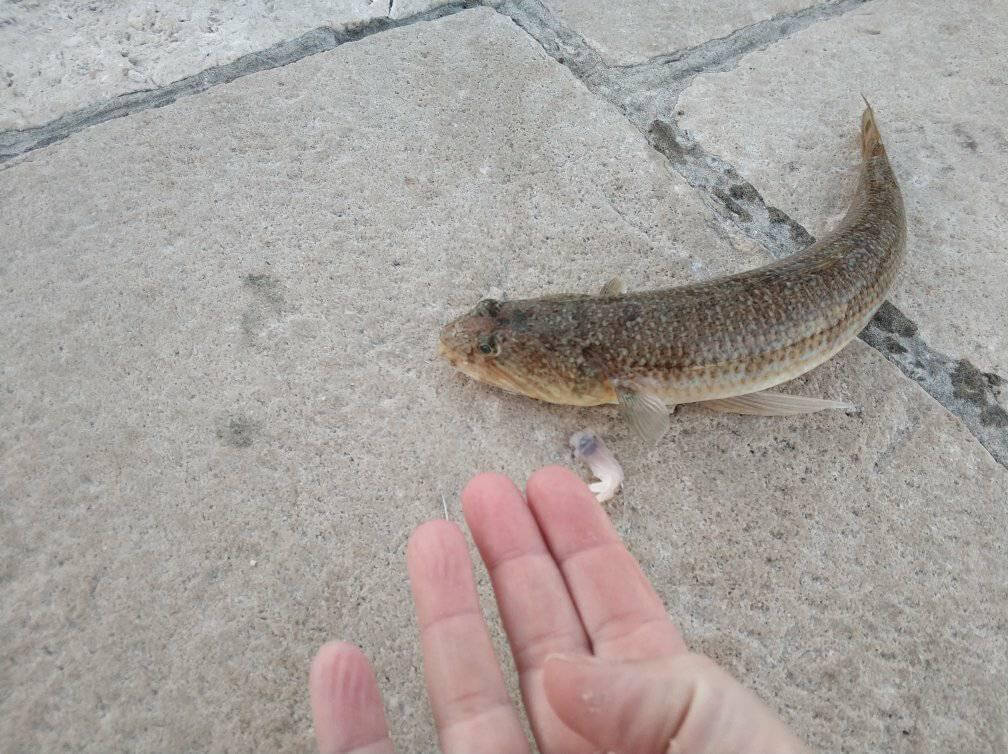
The case, the challenge, the scoop © Iva Tatić
Word on the expert street
A little bit of browsing through the pages of Rovinj Sea Research Centre (CIM), and a few calls, led me to the CIM Senior scientific associate, dr. Andrej Jaklin.
„It looks like Atlantic lizardfish, I saw that fish in person on Pelješac 15 years ago“, said Dr. Jaklin on the phone while looking at the images of the catch I sent him.
Jaklin's memory also seems fit with Pelješac being close to Korčula Island. Still, he said he can't really tell me too much about the fish and recommended it to me to contact dr. Marcelo Kovačić from the Natural History Museum Rijeka. However, dr. Kovačić, a curator for vertebrates, was on vacation, so the call was picked up by Milvana Arko-Pijevac, curator for marine invertebrates.
„I think this could be an Atlantic lizardfish, the head looks like it should, but I'm specialized for invertebrates, mollusks and shellfish“, said Silvana Arko-Pijevac.
So until that point, two experts for marine bio life are certain this is an Atlantic lizardfish (Synodus saurus). Fish, from Atlantic, I thought. Are we talking about an invasive species that manage to come to the northern dead-end of the Mediterranean all the way from the Atlantic? If so, is it hazardous to the domestic sea life of the Adriatic?
Despite recognizing the fish, neither Jaklin nor Arko-Pijevac couldn't say more details, but it's worth noting that the scientific community can once again serve as a role model to everyone who thinks they are experts on everything (both in Croatia but a trend we see spawn worldwide). Instead, my interlocutors accepted and pointed out the limits of their knowledge and suggested me someone who knows more.
Clickbait: It's not just for journalists anymore!
It took me a while to reach Dr. Jakov Dulčić from the Laboratory of Ichthyology and Coastal Fishery at the Institute of Oceanography and Fisheries in Split. First, he was not in the office, and later, he was at a meeting. But, with Arko-Pijevac's claim that Dulčić is the best ichthyologist in all of Croatia, it was worth the wait.
Finally, my mobile phone impulses from Zagreb caught dr. Dulčić in Split, and I excitedly asked him for help. To identify and say a bit more about the mysterious fish fishermen in Korčula failed to recognize, but is suspected to be the Atlantic lizardfish.
„I have to see the photos to say for certain“, said Dulčić.
„I already sent them to your e-mail before this call. Can you please refresh your E-mail?“, I asked with hearable excitement in my voice and suspense in my gut.
The suspense only grew as Dulčić was opening the e-mail.
„Found it!“, he said and I almost screamed out of excitement,
„Yes, indeed, that is the Atlantic lizardfish“, confirmed Dulčić with a relaxed voice while I was ready to ask tons of questions about this weird and possibly invasive species.
„But that is neither exciting nor anything special to catch in the Adriatic“, continued Dulčić with the same chilled tone.
I listened to that sentence with a blank expression fortunately, nobody has seen it except the walls in my apartment.
„You might think it's unusual in Croatian waters because of its name, but it's the normal fish that lives in Adriatic“, added Dulčić.
I couldn't help but think what a sour poetic justice. Being a journalist, a member of the profession in which some of my colleagues try to catch views by clickbait, to be hooked (pun intended) on a clickbait in scientific terminology.
„They can be found across the Adriatic sea, everywhere in Croatia. Their population used to be smaller in the previous years, but it recently got larger. It seems they have certain cycles, but it's nothing spectacular“, he concluded.
„But how come none of the fishermen recognized it?“, I asked puzzled.
„Interestingly enough, it is often caught, but it can rarely be seen on the fish market, and that's a place thanks to which you can usually recognize fish“, explained Dulčić.
However, informing and educating fishers and the general public about marine life in the Adriatic is something dr Dulčić and the Oceanographic Institute are very dedicated to.
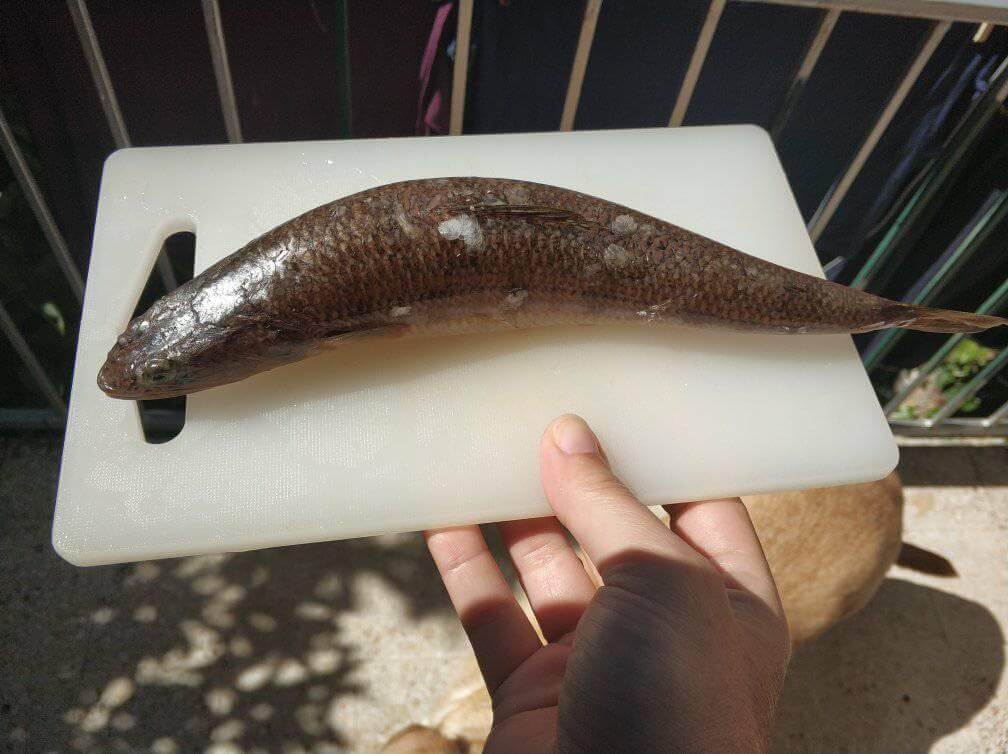
Presenting you the Atlantic lizardfish © Iva Tatić
This is evident by the LEKFishResCRO project.
„This project will address the need to improve knowledge on the trends in Adriatic fisheries with novel methods as well as to acknowledge recent changes in fish biodiversity in a complex Adriatic ecosystem. The central objective of the project will be to evaluate the potential use of the LEK in developing the knowledge base for fisheries management and conservation. The strategy employed for this evaluation will be a two-way discussion between fisherman and other stakeholders from one side and fisheries biologists from another side around the subject of what sorts of indicators of ecosystem health would make sense in light of both the LEK of the fishers and the research-based knowledge (RBK) of the fisheries biologists“, says LEKFishResCRO website, and with loads of materials, you can check yourself.
„We collaborate well with fishermen, we work on their education, and with their tips and images they sent from the field we quickly gather research data“, explained Dulčić.
The invasive species are legitimately a threat to Adriatic, and it comes from the Red Sea through Eastern Mediterranean, but these examples are excellent topics for some other articles.
In the meantime, the mystery fish is identified as a mainstream species in the Adriatic. Somewhat newsworthy (maybe?), but this time my ship returned without a scoop from the stormy cruise in the sea of information.
I sent a message to Iva explaining what she caught (which she already found out on her own, she is a good journalist after all), and I only confirmed that she can unfreeze it and eat it safely. Additionally, I found this recipe at least.
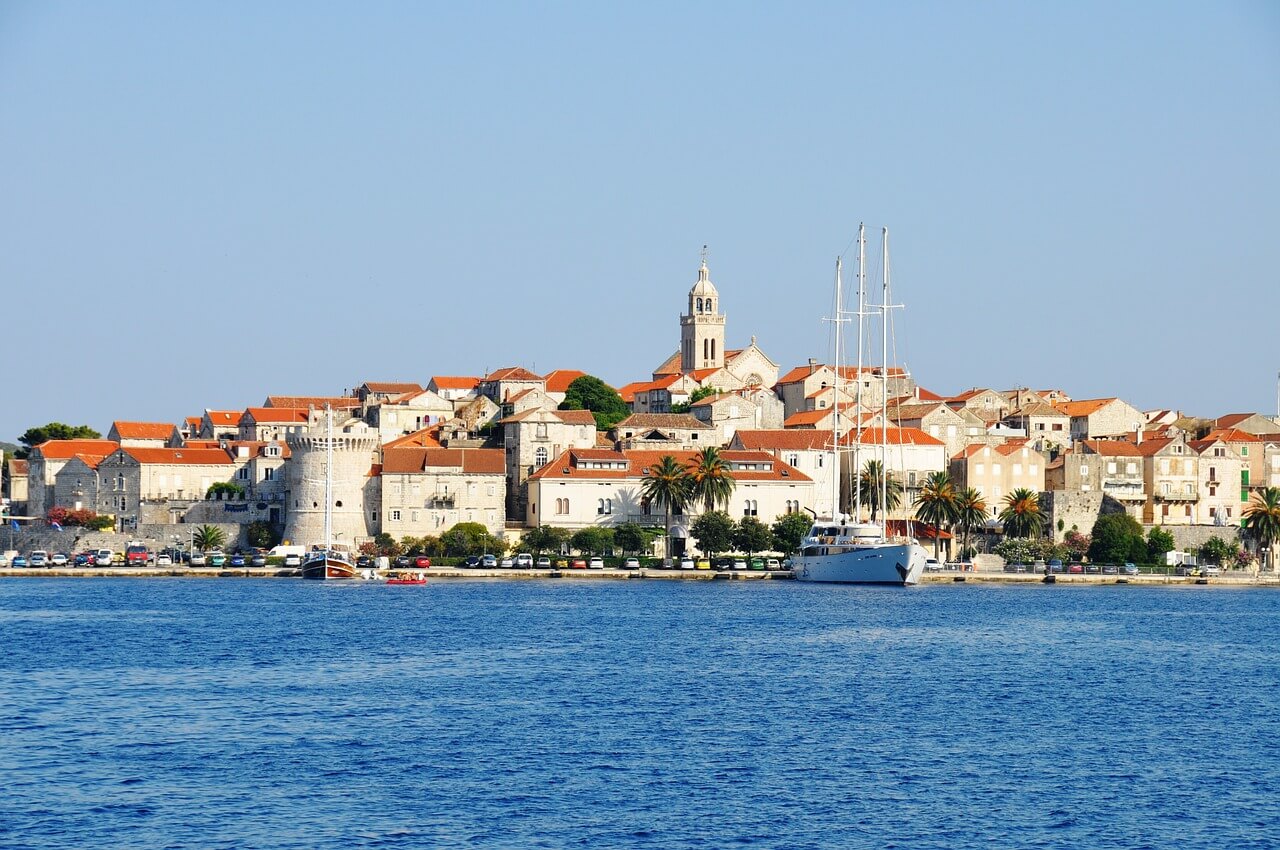
Korčula and Adriatic Sea, Pixabay
Enjoy the Adriatic, but respect marine life
In an attempt to conclude this investigative piece (let's pretend it is one, please) on a socially responsible and eco-friendly note, I asked dr Dulčić if there are any type of fish tourists and locals shouldn't fish because it's on the verge of extinction and if caught it should be returned to the sea immediately. „Such fish is living in areas and conditions where you can't catch it with hooks or nets. But Do not dive out noble pen shells (Pinna nobilis), or disturb mammals such as dolphins. And be careful around sharks and jellyfish“, concluded dr. Dulčić.
Learn more about Korčula on our TC page.
For more about science in Croatia, follow TCN's dedicated page.
Lastovo-Korčula-Dubrovnik Daily Catamaran Service Introduced by TP line
May 24, 2021 - The TP line company for transport by sea introduced the Anastazija ferry service: Lastovo-Korčula-Dubrovnik daily catamaran around the year.
The vessel can cater to 300 passengers and develop a speed of 27 knots.
The ticket fare is 95 kuna during the peak of the summer season for this 75-mile route and 75 kunas outside that period, whereas local islanders are entitled to a lower fare, 60 kunas.
Presenting the new transport service, Dubrovnik-Neretva County Prefect Nikola Dobroslavić said on Monday in the Port of Gruž that this was a great thing for locals from Lastovo. He noted that the government had ensured HRK 12 million as the subsidy for this line.
For more on travel in Croatia, follow TCN's dedicated page.
High-Speed Lastovo - Korčula - Dubrovnik Line to Operate from Mid-May!
May 5, 2021 - Good news today as the high-speed Lastovo - Korčula - Dubrovnik line will operate from May 15, 2021!
The state high-speed line 9808 Lastovo - Korčula - Dubrovnik (and return) will be established this May, and the first trip will take place on Saturday, May 15, 2021. The line will be maintained by the shipping company TP line d.o.o. by the "Anastasia" ship, announced the Agency for Coastal Shipping.
TP line d.o.o. was selected as the most favorable bidder in the negotiated public procurement procedure without prior publication of a call for tenders, and during the next week a contract will be signed with the shipowner to perform temporary transport on the line 9808 Lastovo - Korčula - Dubrovnik.
After signing the contract, the Agency will publish the sailing schedule with the price list on its official website.
TP line d.o.o. will maintain the line until it is taken over by the shipowner who will be selected in the open public procurement procedure for transport on line 9808 Lastovo - Korčula - Dubrovnik, and which proceedings are currently suspended for appeal.
For more information and travel tips to Dubrovnik, be sure to visit our newly launched Total Croatia portal.
For more on travel in Croatia, follow TCN's dedicated page.
Sensational Discovery: 60 Million Year Old Fish Fossils Found on Korcula!
April 13, 2021 – What a sensational discovery! Fish fossils found on Korcula, in Žrnovo, in the hamlet of Postrana, are said to be about 60 million years old!
As Slobodna Dalmacija reports, fossil teeth of fish from the order Pycnodontiformes were discovered in Borovčeva jama. This 43-meter-deep speleological object in the center of the Postrana hamlet was discovered by chance more than two years ago.
Namely, Borovčeva jama was named after Tonči Borovac, who was looking for a suitable place to plant a linden tree when he suddenly discovered the pit.
At the Postrana Local Committee's initiative, the pit was explored by a team of speleologists led by Milan Vojinović from Korčula, a forestry engineer and president of the local society for the promotion and preservation of natural diversity "Adriatica."
During Borovčeva jama's research, fossil fish teeth were discovered, which were recently extracted to the surface, after numerous consents and permits.
"As the renovation of the Korcula City Museum is nearing completion, we decided to take the fossil and include it in the permanent museum exhibition. Obtaining permits for this venture was not easy. Still, we received approvals from the Ministry of Economy and Sustainable Development and the Public Institution for Management of Protected Nature Areas of Dubrovnik-Neretva County. We signed a contract with authorized speleologists to perform works to the pride of the Žrnovo and Postrana residents, and for the benefit of future visitors to the Korčula City Museum," said the Deputy Mayor of Korčula Ivan Šale, a native of Žrnovo.
A depth of 35 meters
But it was harder to pull the fossil out of the pit than to do the paperwork. The pit begins with an awkward narrow entrance. The speleologists descended to a depth of 35 meters, set up a clay hoop, and watered the fossil with a protective rubber, followed by sawing and chiseling of the rock so that the sample could be safely transported to the surface.
It is a Pycnodontiformes fossil, which lived in shallow seas during most of the Mesozoic, spanning 175 million years. Their fossil remains were found worldwide, from the Triassic deposits to the ocean when they became extinct.
They are recognizable by their laterally flattened body and well-developed dentition, which consisted of several rows of rounded teeth with thick enamel surfaces. In short, Pycnodont fish are contemporaries of dinosaurs.
Experts say findings in Croatia are sporadic and limited to Upper Cretaceous sediments along the Adriatic coast. The most common species is Coelodus saturnus, found in localities from Pula to Brač. Some of the specimens from this group of extinct fish are kept in the Croatian Museum of Natural History.
The speleology instructor Branko Jalžić, who, together with his colleague Damir Basar removed the fossil from the Postrana pit, confirmed that this finding would be a valuable part of the Korčula museum exhibition.
Valuable proof and important scientific data
"The project was well-received by all participants, as always when we do underground research on Korcula. We completed the task successfully, the fossil was handed over to the Croatian Museum of Natural History, and it will be returned to Korcula after processing. There is no space in the museum to exhibit a more extensive story from that period, and that is why this small segment will be an important part of the future exhibition. Given the small number of fossils of pycnodont fish, each new find, including this one from Korčula, is a valuable proof of their distribution and important scientific data," explained Jalžić.
He thanked the City of Korcula, the company 'Adriatica,' and the Voluntary Fire Brigade of Korčula, which gave them rooms for sleeping and rest. Many thanks go to Tonči Borovac, who gave them a technique they did not have or they did not have to bring from Zagreb to the island.
He also thank the Public Institution for the Management of Protected Nature Areas of the Dubrovnik-Neretva County, which financed the project and without whose support they would not be able to stay on Korcula.
Not the first fossil found on Korcula
However, this is not the first time speleologists discovered old fish teeth fossils on Korcula. Branko Jalžić, a member of the Croatian bio-speleology society, was a part of a cave research team back in 2018 that found fossil fish teeth at least 100 million years old. The teeth were also found in the same pit, Borovčeva jama. This fish probably lived in this area in the Cretaceous period and belonged to a group called bony fish.
They then discovered a total of three fossils, and in the 80s, the bones of a fossil rhino were found on the island of Korcula.

Fossil fish teeth found in Borovčeva jama on Korčula in 2018 / Adipa.hr
To read more news from Croatia, follow our dedicated page.


